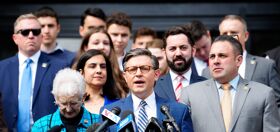
Despite promises of the proverbial and mythical “American Dream,” America’s pluralistic voting system stymies progressive politics. Not only does our “first past the post” mechanism negate majority rules, America’s plurality voting scheme tends toward a two party rule, which can lead to some pretty queer politics.
As we mentioned in last week’s edition of our continuing series, America’s Queer Liberty, French theorist Maurice Duverger proves that voters tend to favor the parties they feel have an actual shot at a legislative slot. These “tactical” voting practices, Duverger writes, “literally pulverize third parties”. Thus, America’s left with two ruling parties: the Republicans and the Democrats. Our nation’s other 46 registered parties, meanwhile, languish in the shadows.
Contrary to what the rest of the world may believe – and the results of our last election indicate – Americans ain’t knuckleheads. And, as we’ll see, America’s Christian conservatives may be the shrewdest, most manipulative voting bloc in American history. Exploiting tactical voting, the religious right successfully knocked the Democrats from their political pedestal, taking Congress by storm during the Republican Revolution. Of course, we queers aren’t dim and launched similar lobbyist efforts. Unfortunately for us, the Right had a much longer – and larger – history of political involvement. And a constituency built into the pews.
Regardless of America’s political shortcomings, we’re lucky to live in a nation with such a vibrant, open and malleable civil society. For better or for worse, pedestrian citizens enjoy a wide range of domestic powers. Political action committees and lobbyists have no doubt shaped contemporary America.
Our recent political history seems to suggest that Evangelicals and other pious politicos count as a new, revolutionary extra-governmental force – a force employed to bolster the Grand Old Party. Evangelicals, however, have built on quite a grand history of social gospel. Aside from America’s puritanical roots, politically motivated preachers have sought a more Biblically endorsed democracy, but the devoted diplomacy really picked up steam toward the end of the nineteenth century As A. James Reichley notes in his 2001 Journal of Political History essay, “Faith in Politics”:
How about we take this to the next level?
Our newsletter is like a refreshing cocktail (or mocktail) of LGBTQ+ entertainment and pop culture, served up with a side of eye-candy.
In the last third of the nineteenth century, northern Protestant pastors commonly urged their parishioners to, “Vote as we pray,” supplementing Republican orators’ appeal to, “Vote as you shot.”… [Then] during the latter part of the nineteenth century and early twentieth, the Social Gospel movement achieved considerable force within American Protestantism…Both leaderships and laities in most Protestant denominations remained predominantly conservative on their political and economic attachments, basing their views on their own interpretations of the more austere and socially traditional side of Christianity as well as on their interest as part of the dominant social group.
President Franklin D. Roosevelt’s New Deal not only saved America from the Great Depression, Reichley writes, but also spurred politically-inclined churches to set up camp in Washington DC, a trend that continued during World War II.
The Evangelicals, however, weren’t the dominant political Protestant force. Not yet, at least. Though active during the 1920s, during which prohibition excited the movement, the Evangelicals fell out of favor during the war years. That all changed during the 1950s when crusader extraordinaire Billy Graham traveled from state to state spreading his gospel. Reichley remarks:
The revivalists campaigns of the 1950s led by charismatic preachers such as Billy Graham had renewed evangelical morale and brought converts to the evangelical churches.
Graham and others’ crusades came a particularly robust time in American history – we’d just won World War II, the economy boomed, as did the babies, and the Civil Rights movement had started bubbling to the surface. This God-fearing group, however, had not yet aligned with the Republican party. In fact, the Republican party hardly resembled the party we know – and sometimes hate – today.
Of the many factors contributing to the rise of the Republican party, two stand out, both of which occurred in 1964: the Voter’s Registration Act and Barry Goldwater’s presidential loss against Lyndon Johnson. The Voter’s Registration Act of 1964, which protected Black Americans’ right to an unhindered, valuable vote, had unintended side effects. In “The Civil Rights Movement and Recent Electoral Realignment in the South,” Fred Shelley, Kimberly Zerr and Adrienne Proffer explain that Southern politicians redrew voting districts to hinder a rise in black power. And, not surprisingly, this gerrymandering helped establish a Republican power base:
…The creation of these “majority-minority” districts has meant that white voters have been dispersed into a larger number of districts. The dispersion of white voters into non-majority-minority districts has resulted in an increase in the number of white Republicans, and a decrease in the number of white Democrats, elected to legislative offices.
1960s era Republicans were intent on dismantling the Democrat’s hold on American government, which it had enjoyed since 1952. Further, the grand old party began to adopt more conservative politics, “…Between the 1950s and 1970s the Republicans had become identified with conservatism.” No doubt the Republican’s post-Goldwater efforts drove this realignment.
The Republicans saw Arizona Senator Barry Goldwater, a die-hard conservative who believed in extremism, as their great white hope, so to speak, and ran him against incumbent president Lyndon Johnson, who took over after John F. Kennedy’s 1963 assassination. Unfortunately for the GOP, Johnson creamed Goldwater. It soon became clear that if the American Republican party wanted to survive, they’d have to expand their base. Fortuitously, America’s once tranquil Civil Rights movement had sparked an entire cultural revolution. Riots, assassinations and bra burnings took American by storm – events which both invigorated some citizens, but left streak marks for others. Perhaps the scariest aspect of America’s metamorphosis came in the form of the homos.
The gay rights movement exploded onto the scene toward the end of the Civil Rights era. We’ve already bored you with the details, so we’ll avoid the nitty-gritty. As many of you know, however, the Stonewall Rebellion birthed the Gay Liberation Front. Though short-lived, the GLF left an indelible mark with its public zaps, coming out campaigns and revolutionary ideology. The GLF’s militancy definitely jarred many American straights – and some gays, too.
Less than a year after the GLF’s founding, more moderate activists broke off to form the Gay Activist Alliance. Though dedicated to furthering gay rights, the GAA took a more measured approach to politics. Rather than linking their cause to a broader social revolution, as the GLF had, the GAA dedicated itself solely to gay rights. This queer-centric attitude set the foundation for America’s oldest continuous gay lobbying group: The National Gay and Lesbian Task Force.
Founded in 1973, the New York-based Task Force dedicated its energies to [making] the Democratic Party responsive to the gay community,” writes John D’Emilio, founding director of the Task Force’s policy institute. And the Force didn’t waste any time. By 1975, two years after its founding, the activists had successfully petitioned the government to hire openly gay men and women. Three years later, the group compiled the first ever examination of companies’ gay policies, an ever-evolving study that still holds weight today. As the Task Force rose to prominence – and anti-gay sodomy laws slowly slipped away – the religious right found its blessed America crumbling around it. And they were preparing for a fight for their “right” to rule. So, too, were the gays.
The culture wars had officially begun and the ballot box became one of the most important battlegrounds. Find out what we mean in the next edition of America’s Queer Liberty, the conclusion of the “Plurality” mini-series.




















GranDiva
Nice thoughts, bad grammar. Or is it no proofreading?
Great historical perspective, and I applaud the efforts; I just wish it was more quotable.
Graywolf48
Unfortunately the ballot box is not a very level battleground. As recently demonstrated again and again, voting machines are easily hacked and entire elections altered (ie: Bush/Cheney, twice). The Republicans have become experts at stealing elections and election tampering.